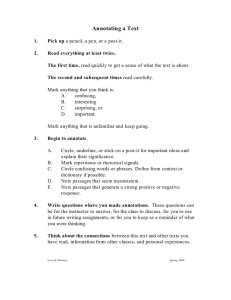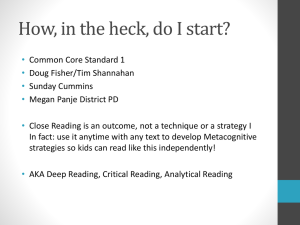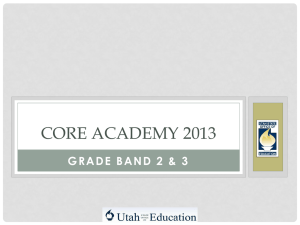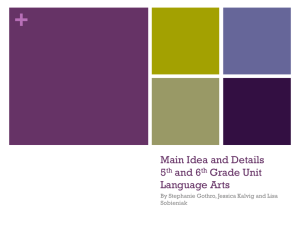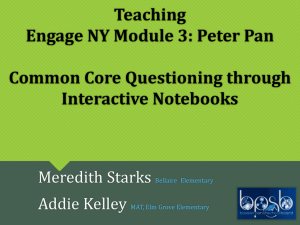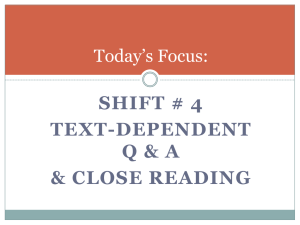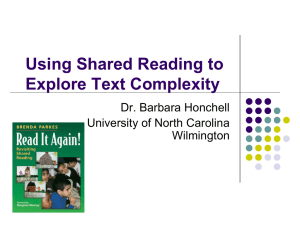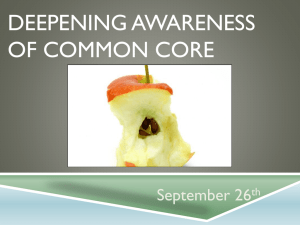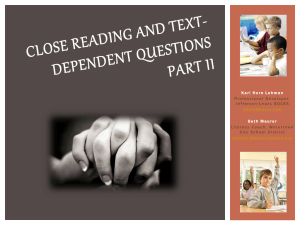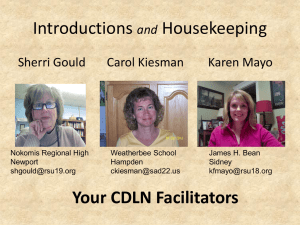Close reading - RPS Monthly Meetings
advertisement
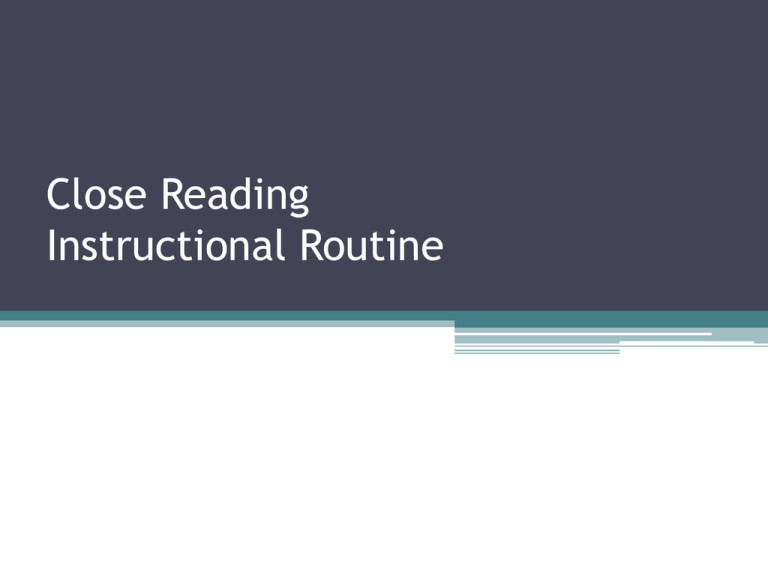
Close Reading Instructional Routine What is close reading? • Close reading is an instructional routine in which students critically examine a text, especially through repeated readings. • Close reading invites students to examine the deep structures of a piece of text. • . . . “x-ray the book for the skeletons hidden beneath the covers.” (Alder, 1940) Deep Structures • The way the text is organized • The precision of the vocabulary to advance concepts • Key details, arguments, and inferential meanings • Consideration of the author’s purpose • How ideas connect to other texts • Ways the reader can consolidate information to formulate opinions Primary objectives of close reading • Afford students with the opportunity to assimilate new textual information with their existing background knowledge and prior experiences to expand their schema Primary objectives of close reading • Build the necessary habits or readers when they engage with a complex piece of text ▫ Building stamina and persistence when confronted with reading that is not easily consumable (Fisher & Frey) ▫ Developing the habit on considering own background knowledge when there isn’t someone prompting them to do so Close Reading 1. 2. 3. 4. 5. 6. The use of short, worthy passages Rereading Reading with a pencil Noticing things that are confusing Discussing text with others Responding to text dependent questions Short, worthy passages • Constraining the amount of text helps students see how to apply a skill or strategy and limits the amount of time required to teach that skill or strategy • Consider the use of specific passages or chunks from a longer piece of text that deserve a close reading Rereading • Explicit and implicit levels of understanding • Willingness to return to the text to read part or even part of it more than once Reading with a pencil • The act of making notes helps us pay attention to the text and allows us to return to the text later when we want to provide evidence • Reading, if it is active, is thinking, and thinking tends to express itself in words, spoken or written. • Writing your reactions down helps you to remember the thoughts of the author. Annotations • Underlining – major points, important statements • Vertical lines at the margin – emphasize a statement or point to a passage too long to underline • Star, asterik, etc. – use sparingly to emphasize the ten or so most important statements Annotations • Numbers in the margins – to indicate a sequence of points made by the author in developing an argument • Circling of key words or phrases • Writing in the margins – to record questions (and perhaps answers) which a passage raises in your mind, to reduce a complicated discussion to a simple statement, to record the sequence of major points Noticing confusing parts • Annotations – use a question mark • Identifying the specific parts of a text that are confusing requires fairly complex thinking ▫ ▫ ▫ ▫ Unknown word Big idea the reader has never considered Structure of the sentences Text structure Discussing the text • Engage in purposeful talk • Manage use of academic and domain-specific language and concepts • Provide an opportunity to learn with others Asking text-dependent questions • Text-dependent questions prompt readers to return to the text • Questions that can only be answered with evidence from the text • Questions should challenge the inferential levels of meaning, such as mood and tone of text, author’s purpose, or how word choice impacts the quality of the reading • Questioning routines – QAR, questioning the author, Bloom’s-taxonomy oriented questions Questioning the author • • • • • (Beck & McKeown, 2006) What is the author trying to tell you? Why is the author telling you that? Does the author tell you clearly? How could the author have said things more clearly? What would you say instead? Close Reading Class Routine 1. Establish the purpose for reading with students 2. First reading: Students read independently, teacher targets specific students who may need more assistance, encourage all students to annotate text and note confusing parts 3. First discussion: Partner talk to check meaning 4. Second discussion: Assessing for understanding and confusions, students share partner discussions, ask for words or portions of the text that were confusing (this guides teacher for modeling) Close Reading Class Routine 5. Second reading: Teacher-led shared reading and think aloud 6. Third discussion: Text-dependent questions The purposes of text-dependent questions are to prompt rereading, encourage the use of textual evidence to support answers, and deepen comprehension explicit implicit meaning 7. Journal writing monthlymeetings.wikispaces.com
